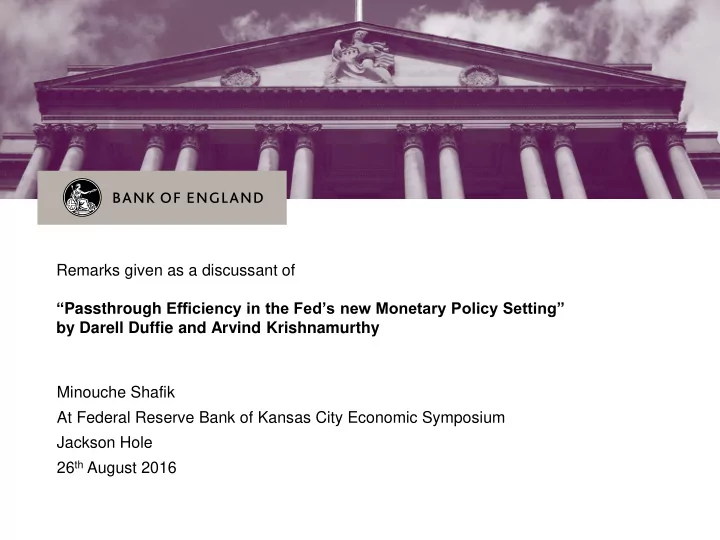

Remarks given as a discussant of “ Passthrough Efficiency in the Fed’s new Monetary Policy Setting” by Darell Duffie and Arvind Krishnamurthy Minouche Shafik At Federal Reserve Bank of Kansas City Economic Symposium Jackson Hole 26 th August 2016
Chart 1 – Dispersion in US money market rates Reproduced from Duffie and Krishnamurthy (2016). The dispersion index (shown in blue) is the weighted mean absolute deviation of the cross-sectional distribution of selected money market rates. The adjusted index (shown in red) is adjusted by subtracting the spread between an unsecured overnight benchmark rate and a secured overnight benchmark rate. See Duffie and Krishnamurthy (2016) for full and important details on data and calculation. • An index of rate dispersion in US money markets shows an increase following the introduction of the Supplementary Leverage Ratio
Chart 2 – Change in Repo market activity since 2013 Percentage change since end-2013 0 -5 -10 -15 -20 -25 United Kingdom (gilts) United States Sources: Federal Reserve Bank of New York, Bank of England and Bank calculations. UK data show the percentage change between end-November 2013 and end-May 2016 (the latest data avaliable) in outstanding gilt repo and reverse repo transactions of a sample of UK resident banks. US data show percentage change between end-2013 and early-August 2016 (the latest data available) in US primary dealers’ repo and reverse repo financing. • Global repo market activity has declined
Chart 3 – Spread between Repo rates and swap rates Indicative 3-month gilt repo and US Treasury repo spread to 3-month Overnight Index Swap (OIS) rate Basis points 20 Gilt US Treasury 15 10 5 0 -5 2010 2011 2012 2013 2014 2015 2016 Sources: Bank of England, Bloomberg and Bank calculations. Three-month moving average. Gilt repo rates are indicative and based on internal rate collection. Data up to 16 August 2016. • The cost of repo has risen
Chart 4 – Survey respondents’ views of sterling money market functioning Net balance of survey respondents who Overall unsecured functioning Overall secured functioning thought markets were functioning well 40 30 20 10 0 May-11 Nov-11 May-12 Nov-12 May-13 Nov-13 May-14 Nov-14 May-15 Nov-15 May-16 -10 -20 -30 -40 -50 -60 Source: Money Market Liaison Committee Sterling Money Market Survey and Bank calculations. ‘Net percentage balance’ is calculated as the difference between the balance of lenders reporting that, on a scale of 1 -5, the market was functioning very poorly (1) to very well (5).The net percentage balances are scaled to lie between ± 100: more extreme responses (1 and 5) attract a weight of 100%, less extreme responses (2 and 4) attract a weight of 50% and central responses (3) attract a weight of zero. • The net balance of survey respondents who think secured markets are functioning well has declined in recent years
Chart 5 – Comparison of leverage ratio and risk-based capital ratio as a predictor of firm failure Risk-Weighted capital ratios of major Leverage ratios of major global banks and subsequent failure global banks and subsequent failure Percent Percent Surviving banks Surviving banks 10 16 Failed banks Failed banks 9 14 8 12 7 10 6 5 8 4 6 3 4 2 2 1 0 0 Source: Capital IQ, SNL, published accounts, Laeven and Valencia (2010). Reproduced from Haldane (2010). • Comparing the leverage ratios and risk-weighted capital ratios of banks who failed during the financial crisis and banks who survived shows that the leverage ratio was a better predictor of failure.
Chart 6 – Bank Rate and Sterling overnight unsecured rate SONIA Bank Rate Basis points 80 70 60 50 40 30 20 10 0 2009 2009 2009 2009 2010 2010 2010 2010 2011 2011 2011 2011 2012 2012 2012 2012 2013 2013 2013 2013 2014 2014 2014 2014 2015 2015 2015 2015 2016 2016 Source: Wholesale Market Brokers’ Association, Bank of England • Sterling money market rates have stayed close to Bank Rate
Chart 7 – Pass-through of risk free rates to retail deposit rates Percentage pass-through since 2013 Q4 125% Sweden(b ) 100% Denmark(c)(d) 75% 50% Germany(b ) 25% United Kingdom fitted value(c)(f) Switzerland(e ) 0% 0 0.5 1 1.5 2 2.5 3 Level of deposit rates in 2013 Q4 (a) Effective household deposit rate on new business, unless otherwise stated, and change between 2013 Q4 and the three months to May 2016 as a percentage of the change in the corresponding maturity of swap rate. (b) Includes interest rates for overnight deposits, and deposits with a maturity of less than one year, between one and two years and greater than two years. (c) Data are for the three months to June 2016. (d) Outstanding interest rates for deposits with a maturity of less than three months, between three months and one year, between one and two years and greater than two years. (e) Published rates for new sight deposits, and on two and three-year cash bonds. (f) Percentage of pass-through is that implied by bivariate regression on the data for other European countries shown in this chart. • Pass through of risk free rates to retail deposit rates tends to be lower when interest rates are lower
Recommend
More recommend